
August 28, 2017
NSF Funds CSE Professor to Model Human-Robot Teamwork in Uncertain Environments
Laurel Riek, associate professor of Computer Science and Engineering at the University of California San Diego, will lead a three-year National Science Foundation (NSF) project on new methods for coordinating teams of robots and people in complex, uncertain environments.
The $750,000 award is shared by UC San Diego and Northeastern University, where Riek’s collaborator, Christopher Amato, is a professor in the College of Computer and Information Science. The grant is part of the National Robotics Initiative under NSF’s Information and Intelligent Systems Division.
“We plan to develop new algorithms to support multi-human, multi-robot teaming in unknown or uncertain environments,” said Riek, who is also a member of UC San Diego’s Contextual Robotics Institute. “The project also has an important application area: helping to reduce clinical workloads in perpetually busy hospital emergency rooms.”
The decreasing cost and increasing sophistication of robot hardware is creating new opportunities for teams of robots to be deployed in combination with skilled humans to support and augment labor-intensive or dangerous manual work, according to Riek. The vision is for robots to free up time of skilled workers so they can focus on tasks at which they are most adept and most enjoy (e.g., problem solving, using human dexterity to manipulate objects, or talking to customers). Meanwhile, robots can help with the distracting or frustrating parts of work, such as delivering materials or fetching supplies.
Riek argues, however, that progress in this area is being stymied by three problems. “First, current methods are not generalizable, and require people to continually reinvent the wheel," she said. "Second, approaches are too rigid, and rely on unrealistic models of human-robot teaming, making them ineffective. Finally, few methods can cope with uncertain environments, where little can be known or planned for in advance.” This project proposes to overcome such problems by creating new methods by which a team’s robots can coordinate with their human counterparts to complete complex challenges that require both sets of capabilities.
The research will build off of previous methods that have been successful in single-robot challenges under uncertainty or partial observability, and in particular, partially observable Markov decision processes (POMDPs). With POMDPs, researchers model robots and the environment, but not humans. For the NSF-funded project, however, Riek will explicitly include people in the models. “For robots to work safely and effectively in human environments," she said, "it is critical that people are included in our models.”
The researchers plan to complete three primary contributions during the three-year project:
- To transform the concept of how multi-human, multi-robot teamwork can occur to reflect the strengths and limitations of the team in a “temporally dynamic, stochastic environment”;
- To develop realistic and general models of human-robot teamwork that consider uncertainty and partial observability; and
- To contribute innovative and scalable techniques for planning and learning in these models.

In addition to the project’s fundamental scientific contributions, Riek intends to focus on a key, real-world application space: emergency departments (ED), where time is critical and conditions change from moment to moment. “EDs involve a great deal of uncertainty, as well as many delivery and supply tasks during high-volume periods,” said Riek. “A team of robots can fluently assist with these tasks, which will free up clinicians’ time to focus on treating patients. This, in turn, will help to improve patient outcomes and safety.”
Simulation of realistic ED conditions will be carried out in the Simulation and Training Center of the UC San Diego School of Medicine. It comprises an entire bottom floor of a building, which allows trainees and providers to practice procedures, teamwork, and crisis response via high-fidelity physical clinical simulation. It contains multiple patient bays and rooms, and is populated with high-fidelity patient simulators (lifelike humanoid robots with complex physiologies, which can breathe, bleed and respond to medication). It also has a full array of resources commonly used in hospitals, such as supplies, monitoring machines, etc.
The new NSF project grew out of previous research undertaken by Riek and recent CSE alumnus Tariq Iqbal (Ph.D. ’17), who is now a postdoc at MIT. They co-authored papers including “Coordination Dynamics in Multi-Human Multi-Robot Teams ”, published in IEEE Robotics and Automation Letters in January 2017; and “Movement Coordination in Human-Robot Teams: A Dynamical Systems Approach ,” published in IEEE Transactions on Robotics in August 2016 (with co-author Samantha Rack).
*Coordinating Human-Robot Teams in Uncertain Environments , NSF Award #1734482, September 1, 2017 to August 31, 2020, NSF National Robotics Initiative.
Laurel Riek Website
Contextual Robotics Institute
Students Complete 'Arguably Most Complex Chip Ever Created in Academia'
On Monday, August 21 at the 2017 IEEE/ACM Hot Chips Symposium on High Performance Chips (HOTCHIPS), researchers from the University of California San Diego, Cornell University, University of Michigan and UCLA jointly unveiled Celerity, the first open-source, RISC-V tiered accelerator fabric system on chip with a neural network accelerator and 511 RISC-V processor cores.

Celerity system on chip at HOTCHIPS 2017.
UC San Diego Computer Science and Engineering (CSE) Ph.D. student Scott Davidson as well as Ph.D. students Khalid Al-Hawaj (from Cornell) and Austin Rovinski (U. Michigan) each gave a 30-minute talk at the HOTCHIPS Conference in Cupertino, CA. Their talk was one of only three academic talks out of a total 29 talks. HOTCHIPS is the premier conference where industry releases details of their latest chips, and the students shared the stage with developers of top chips being released by Intel, Nvidia, Google, AMD, and Qualcomm.
The Celerity SoC is a 5x5-mm 360-million-transistor chip in TSMC's advanced 16-nm technology, split between 5 Linux-capable RISC-V (pronounced risk-five) cores and a NOC-connected manycore of 496 RISC-V cores, plus a binarized neural network accelerator running at 625 MHz..
"The emerging RISC-V open-source software and hardware ecosystem provided a baseline to reduce design, implementation and verification effort," said CSE Professor Michael Taylor (who is joining the University of Washington this fall but will remain an adjunct faculty at UC San Diego). "Then we turned up the awesome factor to create the most powerful RISC-V system in history with 511 cores, a neural network accelerator, and on-chip synthesizable clock and voltage regulation. This is also arguably the most complex chip ever created in academia."

Most of the work of designing the Celerity SoC was done by a team of first- and second-year graduate students, including a large team of 12 from the labs of CSE faculty Taylor and Rajesh Gupta, and Electrical and Computer Engineering (ECE) professors Patrick Mercier and Ian Galton. The student team from UC San Diego included Ph.D. student Scott Davidson, Master’s students Anuj Rao and Paul Gao, visiting researcher Shaolin Xie, staff member Luis Vega, postdoctoral researcher Chun Zhao, former visiting graduate student Ningxiao Sun, and remote collaborator from India's IIT Rourkee, Bandhav Veluri (all in Taylor’s Bespoke Systems Group); Ph.D. student Atieh Lotfi (from Gupta’s lab); ECE grad student Julian Puscar (M.S. ’17) from Galton’s lab; and ECE Ph.D. students Xiaoyang Wang and Loai Salem from Mercier’s lab. The UC San Diego students worked closely with Ph.D. students advised by Prof. Ronald Dreslinski at U. Michigan and Profs. Chris Batten and Zhiru Zhang at Cornell.
"The RISC-V ecosystem played a critical role in enabling a relatively modest team of junior graduate students to fabricate a complex SoC in just nine months," said CSE Ph.D. student Scott Davidson. "While ultimately a success, we still faced non-trivial challenges that we hope the broader RISC-V community can address in the future."
The student presenters said the Celerity SoC achieves a speedup of 700 to 1,220 times due to their use of specialty and many-core tiers in collaboration.
The Celerity project grew out of the CERTUS initiative funded in 2016 by the Defense Advanced Research Projects Agency (DARPA) Circuit Realization At Faster Timescales (CRAFT) program. CERTUS was awarded the first phase of a $5 million, five-year effort to reduce the time it takes to design an SoC by a factor of ten (i.e., to do it in 16 weeks rather than the approximately 160 weeks it currently takes to design a custom ASIC chip for the Department of Defense). The CERTUS project focuses on high-performance SoCs that integrate one or more IP blocks.
In keeping with that mission, the Celerity SoC was specifically designed to contain an array of processing cores based on RISC-V technology to speed up the design process. The team leveraged not only the RISC-V instruction set, but also its software stack, the Rocket Linux-capable processor and memory system generators from Berkeley, as well as verification suite, and system-level hardware infrastructure.
The team taped-out the Celerity chip in April, barely nine months after starting work on the prototype, at an overall cost of approximately $1.3 million (small by comparison with advanced chips developed by industry). Theoretically, the SoC was designed primarily for use in autonomous vehicles, where the neural network accelerator can be critical to processing real-time sensor data in order to make split-second decisions to avoid a collision or other safety challenge.
RISC-V is a new instruction-set architecture (ISA) to support computer architecture research and education. Originally developed by computer scientists at UC Berkeley, RISC-V is fast becoming a standard open architecture for industry implementations under the governance of the RISC-V Foundation, a nonprofit corporation controlled by its members to drive adoption of the ISA (including several RISC-V-based implementations showcased at HOTCHIPS 2017).
"This is a team that worked like a charm," said Gupta in a Facebook post about the demo at HOTCHIPS. He went on to urge potential employers to "look for these students when they graduate. Each one is special."
The team expects first silicon of the Celerity in September, and they will present their results in an academic venue with a conference paper at the first Workshop on Computer Architecture Research with RISC-V (CARRV 2017), set for October 14, 2017 (and co-located with IEEE MICRO this year in Boston, MA).
Incoming Grad Student Co-Authors Guide to "Machine Learning for Humans"
Samer Sabri is an incoming first-year M.S. student in Computer Science at the University of California San Diego. He is returning to school this fall for the first time since completing his undergraduate degree in computer science at Yale University in 2013.

“I picked the department of Computer Science and Engineering [CSE] at UC San Diego because I’m very interested in the intersection between machine learning, cognitive science and philosophy,” explained Sabri. “UC San Diego has amazing people working in that space and I’m interested in being part of that quest.”
Sabri’s interest in machine learning should come as no surprise. He is part of a two-person writing team that developed "Machine Learning for Humans," an easy-to-read online primer on what machine learning is all about. Together with entrepreneur Vishal Maini, Sabri wrote the five-part "roadmap" that went live on the website Medium on August 19. The full series is available for download (and will soon be published as an e-book).
After introducing "Why Machine Learning Matters" and the field’s history, the next three chapters delve into supervised learning from the simplest linear regression to more advanced tools such as decision trees and random forests, and introducing cross-validation, hyper-parameter tuning and ensemble models. In part three, the authors switch to unsupervised learning, including clustering, principal components analysis (PCA) and singular value decomposition (SVD). Subsequent chapters delve into neural networks and deep learning, and reinforcement learning, including Markov decision processes, Q-learning and the value learning problem.
Sabri and Maini wrote the entire series for two primary audiences: non-technical people who are willing to engage with technical concepts, as well as "technical people who want to get up to speed on machine learning quickly. The series, adds Sabri, is also for "anyone who is curious about how machines think."
"This guide is intended to be accessible to anyone," adds the incoming CSE grad student. "Basic concepts in probability, statistics, programming, linear algebra, and calculus will be discussed, but it isn’t necessary to have prior knowledge of them to gain value from this series."

online, multiplayer game called Dota 2.
In short, "Machine Learning for Humans" is written as a quick digest of high-level machine learning concepts that can bring someone up-to-speed on the subject in two or three hours, and the authors use simple, plain English for explanations, often accompanied by math, code and real-world examples. The series is also fresh with examples, some as recent as August 2017 (e.g., the OpenAI announcement that the open-source AI had defeated top professionals in one-on-one matches playing the online, multiplayer game Dota 2).
Prior to enrolling in graduate school at UC San Diego, Sabri worked for the management consulting firm McKinsey & Co., advising Fortune 100 companies from its Silicon Valley office. In 2016 Sabri also founded TableScribe, a company to market an Excel-based business intelligence tool for small-and medium-sized businesses. (The TableScribe software is currently in free beta release.) Sabri earlier co-founded, Conigo Labs, based in his native Lebanon, to offer customized code to automate processes such as workflow tracking and scheduling, cleaning data, and consolidating data from various sources -- primarily for clients in the insurance, consumer packaged goods and manufacturing sectors. (TableScribe effectively puts the ability to customize data-to-report processes into the hands of non-programmers, potentially cannibalizing demand that Conigo Labs was originally set up to fulfill.)
For now though, Sabri says he is putting his companies on the back-burner. “I am going to focus on my studies and my research,” he said. “If all goes well, I’ll slowly dial up the ventures again and hopefully make some money in the process.”
Machine Learning for Humans
Samer Sabri on LinkedIn
Help UC San Diego Scientists Study Link between Body Bacteria and Autoimmune Diseases
The public's help is being enlisted in the Microbiome Immunity Project, what's thought to be the biggest study to date of the human microbiome — the communities of bacteria and other microbes that live in and on the human body, where they influence our health. The project is co-led by Pediatrics and CSE professor Rob Knight, director of the Center for Microbiome Innovation at UC San Diego, with collaborators at Broad Institute of Harvard and MIT, Massachusetts General Hospital and the Simons Foundation’s Flatiron Institute.
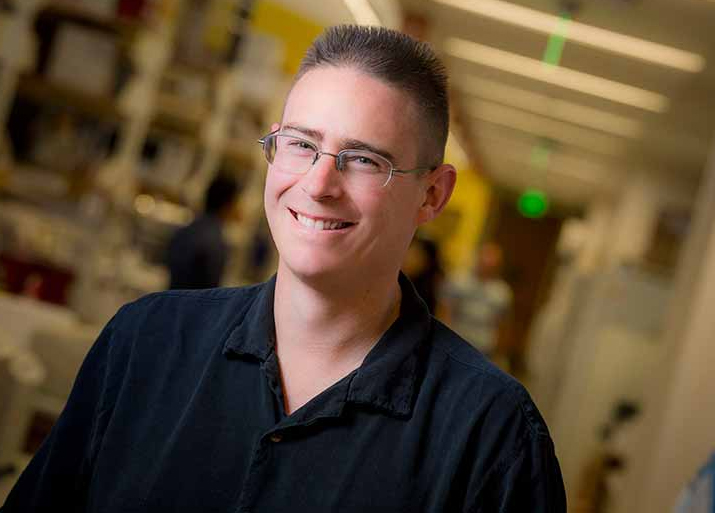
Since studying the entire human microbiome would be almost impossible with traditional methods, massive supercomputing processing power is being crowdsourced via IBM's World Community Grid. Volunteers download a secure software program that automatically detects when a computer can offer spare processing power, then taps it to run virtual experiments on behalf of researchers. Anyone with a computer and an internet connection can join the World Community Grid and sign up to support the Microbiome Immunity Project at www.worldcommunitygrid.org
At UC San Diego, Knight lab postdoctoral researcher Tomasz Kosciolek is also working on the project, together with Chemistry and Biochemistry professor Rommie Amaro, and Bryn Taylor, a graduate student mentored by both Knight and Amaro.
The team will use the surplus processing power on World Community Grid volunteers' computers to conduct millions of virtual experiments. They aim to map three-million bacterial genes found in the human microbiome and predict the structure of their associated proteins.
The study’s goal is to help scientists better understand the microbiome’s interaction with human biochemistry and determine how that interaction may contribute to autoimmune diseases, such as type 1 diabetes, Crohn’s disease and ulcerative colitis. With better understanding, scientists might be able to more easily prevent and treat these diseases. The researchers will make their data publicly available to other scientists, accelerating the advancement of scientific knowledge in this important area of research.
“Had World Community Grid not existed, we wouldn't have even contemplated this project,” Knight said. “By harnessing the efforts of volunteers, we can do something that exceeds the scale of what we have access to by a factor of thousands. For the first time, we're bringing a comprehensive structural biology picture to the whole microbiome, rather than solving structures one at a time in a piecemeal fashion.”
Since its founding in 2004, World Community Grid has supported 29 research projects on cancer, HIV/AIDS, Zika, clean water, renewable energy and other humanitarian challenges. To date, World Community Grid, hosted on IBM Cloud, has connected researchers to $500 million U.S. dollars' worth of free supercomputing power. More than 730,000 individuals and 430 institutions from 80 countries have donated more than one million years of computing time from more than three million computers and Android devices. Volunteer participation has helped researchers to identify potential treatments for childhood cancer, more efficient solar cells and more efficient water filtration.
UC San Diego researchers are also involved in OpenZika , a World Community Grid project launched in May 2016 which aims to identify drug candidates to combat the Zika virus.
Drone Truthing Makes Geisel Library a Test Case
A team of researchers from across UC San Diego is developing a new approach for detecting damage to buildings during earthquakes and other extreme events.
They came together at the Geisel Library recently to use lasers and drones to create a digital record of the structure that will serve as a baseline health assessment. In the event that a sizeable earthquake hits nearby, the team will reconvene to retake the digital measurements and assess any damage to the building such as tilting or cracks. (View photo gallery .)
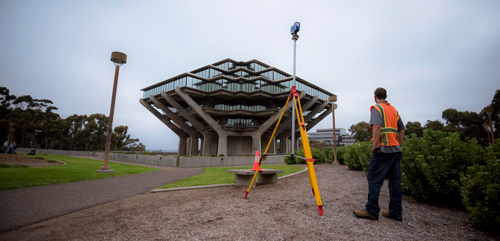
record of Geisel Library. Photos by Erik Jepsen/UC San Diego
The information is intended to provide both researchers and emergency responders with more detailed information on how structures respond during the earthquakes—beyond the simple visual inspection of buildings currently in use—prior to allowing them to reopen.
According to researchers at the Scripps Institution of Oceanography and Jacobs School of Engineering at UC San Diego who are spearheading the project, the iconic library is the perfect location to begin what they hope will become an effort to digitize the entire campus.
“We are using this culturally significant building on campus as a reference model to help detect structural changes over time,” said Falko Kuester, a professor of structural engineering and CSE faculty-affiliate who serves as director of the Qualcomm Institute's Cultural Heritage Engineering Initiative (CHEI) and DroneLab.
For Yehuda Bock, a distinguished researcher and director of the Orbit and Permanent Array Center at Scripps Oceanography, the primary motivation for the recent survey of Geisel Library was to integrate structural monitoring into his early-warning prototype system for earthquakes and tsunamis.
“Our system tracks ground motions at a millimeter level of accuracy,” said Bock. “This allows us to detect large earthquakes within the critical first minute before the shaking begins.”
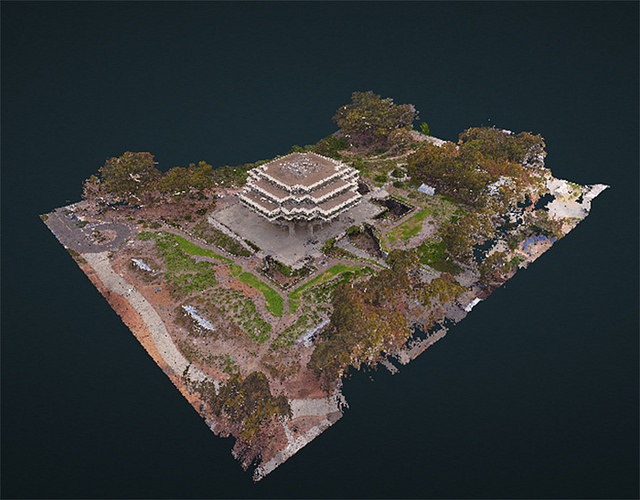
captured by drones and used structure-from-motion
techniques to create a 3D computer model of Geisel
Library and its surroundings.
Six months ago, Bock equipped the Geisel Library with sensors that continuously measure ground motion from the many faults that crisscross Southern California. The technique he helped pioneer, called seismogeodesy, relies on a combination of GPS receivers and accelerators to very rapidly pinpoint the location and magnitude of strong earthquakes—6.0 magnitude or greater—before the hazardous trembling begins.
The late-July project involved nearly two hours of drone flights led by CHEI researcher Eric Lo, capturing more than 1,000 high-resolution images of the Geisel Library that will be turned into a photorealistic model of the structure. Lo’s drone survey was accompanied by a several-hour ground survey by professional land surveyor Richard Maher using lidar (light detection and ranging), an instrument that sends pulsating laser lights at an object to provide a precise 3-D model. By combining these techniques, the team will create a geometrically as well as visually detailed and accurate final model.
Bock’s GPS sensors provide a precise 3-D reference to tie together the high-resolution drone and lidar imagery, allowing for the accurate detection of subtle permanent displacements of the structure’s outer shell as a measure of its integrity after an event.
.jpg)
Engineering Initiative ran the drone photography project.
Kuester currently leads research teams developing drone technology for crisis management and response, as well as applying the work to study and help preserve ancient Mayan structures in Mexico, Neanderthal caves in Italy, and shipwrecks and coral reefs in Bermuda. For him, this project is a first step to create a digital surrogate or as he calls it, a “cyber-twin” of the campus, before new buildings and bridges transform the campus’s physical appearance in the future.
Although Kuester often looks at ancient buildings and ruins, he points out that “it’s important to also document modern buildings before the perils of time or extreme events cause them to deteriorate or create an even less fortunate outcome.”
The digital record on the condition of buildings as they exist today provides a baseline for comparison in the future as a building ages, or in the case of a fire, earthquake or other natural hazard, actionable data, according to the researchers, to swiftly respond and mitigate risks.
Within a few minutes of completing the drone flights, Lo had a quick 360-degree rotating view of the geometrically shaped building from the images collected during the flights for view in 3-D.
Another important motivation for Bock and Kuester is to have students involved in real-world research projects, both on site and as classroom teaching tools.
“As an educator, it’s important that I expose my students to real-world conditions,” said Falko. “The contribution to science needs to be useful and usable.”
Kuester and Lo will also be turning the drone imagery into a virtual reality experience for those interested in flying themselves around the outside of the library.
Bock and Kuester are hoping the project will attract more interest and funding to seismically monitor and digital archive all buildings throughout the UC San Diego campus.
Meanwhile, at Bock’s lab at Scripps Oceanography, the seismic monitoring data is continuously streamed back in real-time. When the next powerful quake strikes, the system will alert him first of the primary signal, called a P-wave, which indicates an earthquake has taken place, and that the destructive S-wave, the one responsible for the strong earth-shaking, is seconds to minutes away. The GPS and seismic sensors on the Geisel Library will quickly indicate whether it has suffered significant shaking and displacement.
For Bock and Kuester, how these buildings and others respond to outside influences is an important component to how we better prepare as a society for extreme events in the future.
UC San Diego Ranked #2 Nationwide for Serving the Public Interest
The magazine Washington Monthly has named the University of California San Diego the second ranked public university in the U.S. for promoting upward social mobility, producing groundbreaking research and serving the nation’s public interest. The national magazine’s annual rankings recognize what universities are doing for the public good and have consistently rated UC San Diego among the country’s best colleges for over a decade.
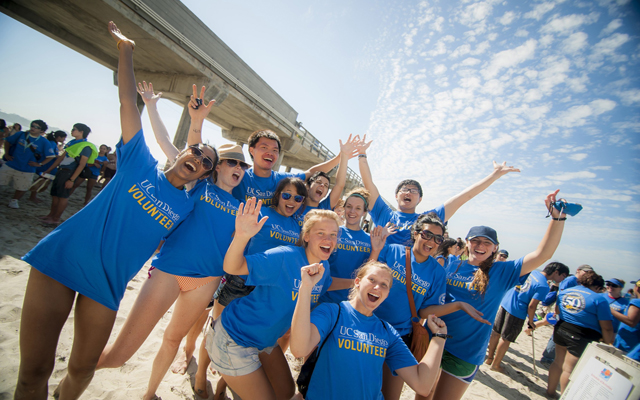
three million hours of community service every year, just
one barometer in the university's #2 position in the
Washington Monthly annual rankings..
“From our research in climate science and the human microbiome," said Chancellor Pradeep K. Khosla, referring to the pioneering microbiome research led by CSE and Pediatrics Prof. Rob Knight, "to our commitment to public service and social mobility, UC San Diego’s academics center on tackling the pressing challenges of our time to benefit humankind.”
The Washington Monthly rankings methodology measures how well universities produce research, train the next generation of scientists and PhDs, and instill in their graduates an ethos of public service. The magazine editors noted, “UC San Diego, our second-ranked public university, is a research powerhouse where over one-third of students come from first-generation and low-income families. Very few institutions manage the combination of academic excellence and economic opportunity so well.”
The publication also rates colleges that are doing the best job of helping non-wealthy students attain marketable degrees at affordable prices. UC San Diego was listed as 24th in the Best Bang for the Buck Colleges in the West category.
Research
UC San Diego performed very well in the rankings for preparing undergraduates for graduate school as well as discovering new technologies and creating ideas. The campus recently set a record $1.16 billion in sponsored research funding for the FY2017 (July1 -June 30), a 3 percent increase from the previous year.
Social mobility
Washington Monthly praised UC San Diego for its socioeconomic diverse student body, and recruiting and graduating low-income students. About 60 percent of students on campus receive some form of financial aid. Also, one-third of students are the first in their family to attend college or come from a low-income household. A recent study reported by the New York Times named the university as one of the best colleges in the country for providing upward social mobility to diverse students across California and the country. Among highly selective public universities, UC San Diego has the highest population of low-income students; and, with a degree from the campus, these students have a high probability of thriving in the middle class and beyond.
Service
As part of its academic mission, UC San Diego encourages students to give back to their country. The school prepares students to succeed in today’s world with interdisciplinary, entrepreneurial and solutions-oriented skill sets. These efforts were recently recognized with an official Changemaker Campus designation from Ashoka U, the world’s largest network of social entrepreneurs. Only 40 universities around the world have earned the Changemaker distinction and UC San Diego is the first University of California campus to receive this designation.
On average, nearly 20,000 UC San Diego students complete more than 3 million hours of community service every year.
|
UPCOMING EVENTS MONDAY, OCTOBER 16, 2017 |
Microbiome Research: From Products to DataThe CSE Distinguished Lecture Series for the Fall 2017 quarter is set to get underway in early October. Among the speakers now scheduled for the series is Nikos Kyrpides, who works at the Department of Energy's Joint Genome Institute. He will focus in his talk on "Microbiome Research: From Products to Data." 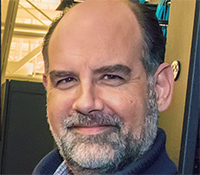 Date: Monday, October 16, 2017 Abstract: Microbiology is experiencing a revolution brought on by recent developments in sequencing technology. The unprecedented volume of microbiome data being generated pose significant challenges with respect to standards and management strategies, but also bear great new opportunities that can fuel discovery. Computational analysis of microbiome samples involving previously uncultured organisms, is currently advancing our understanding of the structure and function of entire microbial communities and expanding our knowledge of genetic and functional diversity of individual micro-organisms. I will describe some of our computational approaches and will emphasize the value of assemblies in enabling the exploration of large metagenomic datasets and the discovery of novelty. I will discuss the results for the discovery of novel phylogenetic lineages as well as the exploration of the viral dark matter. Bio: Dr. Nikos Kyrpides was born in Greece, where he studied Biology at the Aristotle University of Thessaloniki. He received his PhD in Molecular Biology and Biotechnology from the University of Crete, then pursued postdoctoral studies in Microbiology with Carl Woese at the University of Illinois at Urbana-Champaign and in Bioinformatics with Ross Overbeek at the Argonne National Laboratory. From 1999 to 2004 he worked in the biotech industry in Chicago, IL, where he led development of the genome analysis and bioinformatics core. He joined the DOE Joint Genome Institute in 2004 to lead the Genome Biology Program and the development of the data management and comparative analysis platforms for microbial genomes and metagenomes. He became the Metagenomics Program head in 2010, and he founded the Prokaryotic Super Program in 2011, which he still leads along with the Microbiome Data Science Group. Dr Kyrpides has over 25 years of research experience in sequence analysis, bioinformatics, and microbial genomics and published more than 550 papers in the field. He led the development of several pioneering data managements systems in microbial genomics and metagenomics, which are widely used in the community and have several thousand users across the world. Research in his group is currently focusing on Microbiome Data Science. This includes the understanding of structure and function of various microorganisms and microbial communities and the elucidation of the evolutionary dynamics that shape the microbial genomes. To accomplish that, his group is developing novel methods for enabling large-scale comparative analysis, as well as mining and visualization of big data. Some of Kyrpides' current projects include the sequencing and comparative analysis of thousands of archaeal and bacterial type strains, uncovering Earth's Virome, the delineation of host-virus interactions, and the discovery and characterization of novel protein families from microbiome data. He has received several prestigious awards including the van Niel International Prize for Studies in Bacterial Systematics, an outstanding performance award from Lawrence Berkeley National Laboratory, and the Academic Excellence Prize from Empeirikeion Foundation. He is an elected fellow of the American Academy of Microbiology and he is on the list of the most Highly Cited Researchers from 2014-2016. Host: CSE Prof. Pavel Pevzner
|

